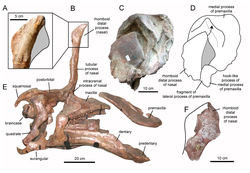Tsintaosaurus
|
Tsintaosaurus Temporal range: Late Cretaceous, 70 Ma |
|
|---|---|
 |
|
| Holotype skull with broken crest | |
| Scientific classification | |
| Kingdom: | Animalia |
| Phylum: | Chordata |
| Class: | Reptilia |
| Clade: | Dinosauria |
| Order: | †Ornithischia |
| Suborder: | †Ornithopoda |
| Family: | †Hadrosauridae |
| Tribe: | †Tsintaosaurini |
| Genus: |
†Tsintaosaurus Young, 1958 |
| Type species | |
|
†Tsintaosaurus spinorhinus Young, 1958 |
|
Tsintaosaurus (/tʃɪŋdaʊˈsɔːrəs/; meaning "Qingdao lizard", after the old transliteration "Tsingtao") is a genus of hadrosaurid dinosaur from China. It was about 10 metres (33 ft) long, 3.6 metres (12 ft) tall and weighed 3 tons. The type species is Tsintaosaurus spinorhinus, first described by Chinese paleontologist C. C. Young in 1958.
A hadrosaur, Tsintaosaurus had a characteristic 'duck bill' snout and a battery of powerful teeth which it used to chew vegetation. It usually walked on all fours, but could rear up on its hind legs to scout for predators and flee when it spotted one. Like other hadrosaurs, Tsintaosaurus probably lived in herds.
In 1950, at Hsikou, near Chingkangkou, in Laiyang, Shandong, in the eastern part of China, various remains of large hadrosaurids were uncovered. In 1958 these were described by Chinese paleontologist Yang Zhongjian ("C.C. Young") as the type species Tsintaosaurus spinorhinus. The generic name is derived from the city of Qingdao, earlier often transliterated as "Tsintao". The specific name means "with a nose spine", from Latin spina, and Greek ῥίς, rhis, "nose", in reference to the distinctive crest on the snout.
...
Wikipedia
